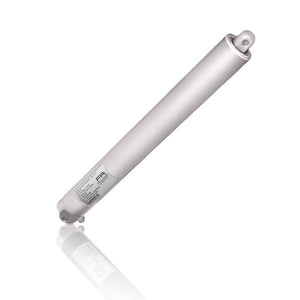We're proud to introduce our new line of Actuators featuring Optical Sensors to provide Feedback.
When you need to know exact positioning of your actuators, the OS Series is what you need. This powerful, reliable actuator comes with a built in optical sensor that provides feedback when you need it. The OS Series have no built-in controller, but do provide single phase pulses as position feedback signal that can be input to an external controller such as an Arduino.
The OS series is equipped with a 10 hole optical encoder disk that with the gearing to the actuator output shaft will send 100 pulses/inch of stroke ( +/- 5 pulses).
There are three force options available ranging from 35 to 400 lbs. These units come equipped with built-in limit switches, are manufactured with high-grade aluminum outer and inner tubes, and come in various stroke lengths from 1" - 30".
Feedback Actuators have either built-in Potentiometers, Hall sensors or Optical Sensors.
We offer Linear Actuators that have all 3 Feedback options. (Optical, Potentiometer and Hall sensor) each Feedback type his their own benefits and drawbacks. As such we wrote an article about the advantages and disadvantages for each one, so you can really understand the difference to help you decide which will best suite your application.
Article: Understanding how Feedback Linear Actuators work
Our 3 types of Feedback Linear Actuators include:
- Potentiometer style. These Actuators offer a 3 wire voltage divider systems. Basically the Potentiometer has 3 wires, where one wire represents 0v to represent the retracted position of the Actuator, +ve input voltage to represent 100% of the max travel. So if you put 12v into the potentiometer that 12v will represent the maximum stroke. and the 3rd wire is used to actually measure the voltage along the actuator stroke.
- Optical feedback style. These actuators use an optical sensor and a rotating disc with holes in it that's attached to the gearbox inside the Actuators. The position is created by counting the pulses from a starting position. These are very reliable with very his resolution.
- Hall Sensor Effect. These Actuators are very similar to Optical, and in fact the voltage input is the same and the output signal is the same. The Hall effect simply uses a magnetic disc that spins within the Gearbox, and the sensor just measures the number of revolutions by counting the positive and negative poles of the magnet.
Synchronous Control Board for Feedback Actuators
The Synchronous Control Board allows you to move multiple Feedback actuators in sync with the same speed irrespective of load. Non-synchronized actuators can lead to bending loads which is likely to cause damage to the actuators.
The FA-SYNC-2 will allow you to move two actuators in sync and the FA-SYNC-4 will allow movement of four actuators. Operate with our Optical Feedback (not the 35lb model), Bullet 36, or Bullet 50 actuators (compatible with both 12V and 24V)
There are only two reasons you need a feedback Actuator.
You need to know the position of the actuator because you need to move it to a specific location/s over and over again.
You need to control two or more actuators to run at the same speed or in sync with each other.
The level of precision you require and controller you are going to use really dictate which type to use. For creating a control system an Arduino Controller is by far the most common.
If you would like to learn how a Linear Actuator works or what the inside of a Linear Actuator looks like click here.
To learn the difference between all the different types of feedback types click here





